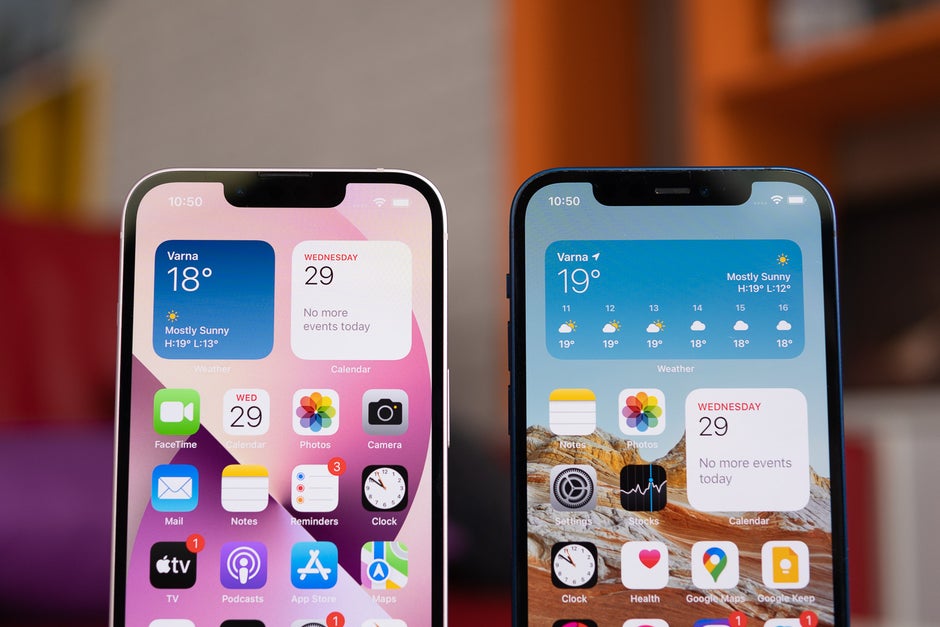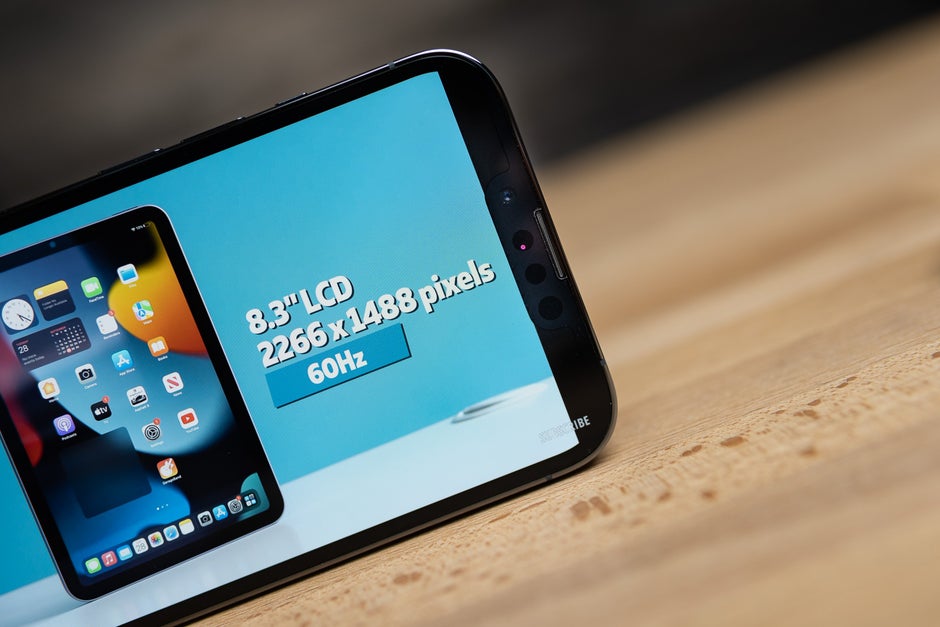Apple iPhone 13 review – PhoneArena
Apple iPhone 13 design and display
Bright n’ heavy, not that notchy
The iPhone 13 is all about subtle but compounded design differences from an older iPhone that make it look and feel like a completely new Apple handset in the palm, and not only because it’s heavier. After all, the extra weight brought longer battery life!
Both the iPhone 12 cases and screen protectors don’t fit the iPhone 13. The new iPhone buttons are offset and the body is thicker because of the bigger battery, while the screen protectors won’t match the smaller notch on the 13, so you’d have to get new ones.
Perhaps the most striking difference in design, however, is the camera bump on the back that now includes the larger sensor of the iPhone 12 Pro Max, and a new ultrawide camera module that warranted a diagonal repositioning.
Did Apple do it so that your street cred is defended, as people would immediately recognize you are carrying the latest iPhone with the Cinematic video mode and new camera features? Bazinga!
Moreso the new iPhone 13 now comes in new colors – starlight, midnight, pink, and blue – that are different from last year’s iPhone 12 blue, green, black, white, and purple hues, while even the (PRODUCT)RED version is darker red now.
Is the iPhone 13 waterproof?
- Yes, up to 20 feet for up to 30 minutes
Apple may have been late to the iPhone water-resistance game, but it now prides itself in providing one of the highest waterproofing standards of all phones barring niche tough and durable models.
The iPhone 12 series, for instance, have IP68 rating like most of them water-resistant phones, but they can dive up to much deeper, 19.6 feet (six meters) depths of water for 30 minutes compared to virtually all other waterproof handsets.
Not that the others can’t withstand such pressure, but anecdotally and not in an official specs list as Apple touts its abilities. The iPhone 13 doesn’t dive any deeper than the already set record, so it is able to chill at the 20 feet bottom of a freshwater lake, too, but it hardly needs to do more than that.
A brighter display for everyday tasks
Nearing 60Hz perfection
Moving on to the front, the iPhone 13 display specs – 6.1 inches diagonal, 1170×2532 pixels, 60 Hz OLED display – seem identical to its predecessor but there are a few major differences. First off, the Super Retina XDR display is now much brighter than on the older iPhone, and with very rich contrast, as is typical for all OLED panels. Granted, Apple lists 1200 nits of peak brightness for both last year’s iPhone 12, and the iPhone 13, but that is to watch HDR content, while the daily “typical” brightness of the iPhone 13 is listed 800 nits, much better than the 625 nits on previous iPhones.
Apple’s tough Ceramic Shield cover for the brighter screen is not a new feature, as it is present on the regular iPhone 12 model, too, yet the iPhone 13 is heavier, so the extra OLED display protection is even more welcome here.
Display measurements and quality
The Ceramic Shield covering isn’t stopping the iPhone 13 display from returning near perfect color representation in all our tests, as you can see from the color chart that fits each measured display hue neatly on the standardized gamut squares.
Add to these measurement the spot-on gamma level of 2.2, a measurement of true color used as the balance standard for graphic and video professionals, and the 6586 Kelvin white balance score that overlaps the true white 6500K point to the tee, and you’ll have one of the most color-credible mobile displays in your hand with the iPhone 13.
Still, when you scroll on it next to the 13 Pro, a glaring lack of fluidity is immediately noticeable in comparison, especially in the interface animations, Settings, and in Reading mode.
- Use your Apple Watch to unlock iPhone 13 with a mask on
- Cover half your face with the mask, then use the iPhone 13 “Alternative appearance” Face ID option with the other half.
The best screen-to-body ratio on an iPhone so far
Taller notch eats into 18:9 content, though
The new notch, however, brought a better screen-to-body ratio to the iPhone 13 thanks to a significant shrinkage. Apple achieved the smaller notch by integrating the earpiece in the top bezel, like a normal phone maker, and then housing the four major Face ID components – the infrared camera, flood illuminator, selfie snapper, and dot projector – underneath it.

Honey, I shrunk the iPhone 13 notch!
That left plenty of empty space in the middle where the earpiece and mic used to sit, so Apple simply clustered the Face ID kit elements closer to each other and reduced the empty space on the sides to make the notch much more compact than it is now. It is slightly taller than before but much narrower at 0.99″ (26mm) in width, instead of the 1.38″ (35mm) that Apple has been using to house the Face ID components and earpiece.

The new notch is now visible when watching wider video
Still, the new notch is reduced by 20% overall, making iPhone design history as it will be the first major change in the front since, well, 2017 when the first iPhone with a notch made a cameo.
While the cutout is now protruding slightly deeper into the display, that extension is peanuts compared to the notch width shrinkage, so its ill effect on the iPhone 13’s screen-to-body ratio is rather negligible compared to the display gains from narrowing the notch.
Since the notch cameo, Apple’s iPhones immediately broke the 80% screen-to-body ratio threshold, with the iPhone 12 commanding 86% screen measured from the total handset dimensions when we account for the notch.
The notch shrinkage now easily pushes the iPhone 13 towards the 88% true screen-to-body ratio mark, still a far cry from the best Android phones in that respect, yet the iPhone 13 series is now with the best screen real estate on an iPhone so far.
The main wide camera sensor is now with larger, 1.7-micron pixels, and the bigger camera module is most likely directly borrowed from the iPhone 12 Pro Max where it enjoyed exclusivity. That means that the iPhone 13 now lands has the 12 Pro Max’s superior Sensor Shift image stabilization.
The new iPhone now has a new ambient light sensor that measures the amount and direction of light much more granularly to aid the computational photography algorithms.
These are the iPhone 13 camera upgrades in terms of hardware, while the new Apple A15 chipset with its unsurpassed image processing speeds allows for much faster and more precise computational photography. Talk is cheap, though, so let’s have a look at our iPhone 13 review camera samples, including Portrait mode, digital zoom, and macro shots.
We’d have to admit that Apple struck gold with the decision to trickle the iPhone 12 Pro Max camera down to the iPhone 13/mini models. Literally, as it is using an already developed and ordered sensor to achieve the breathtaking colors and dynamic range you see in the photos here on the cheap.
Color credibility leaves something to be desired but white balance set towards warmer “yellow” tones has become somewhat of a trademark for iPhone pictures and they make all the colors pop and crackle.
A traditionally weak camera area we noticed on the iPhone 13 is the digital zoom which is of lower quality compared to the telephoto or crop zoom of the competition in the same price range. If magnification is important to you, just go for the iPhone 13 Pro/Max instead.
On the other hand, the iPhone 13 more than compensates for the zoom mishaps with improved night shots and video mode, thanks to the larger main camera sensor and its wider lens aperture.
As you can see, the difference in the iPhone 13 vs iPhone 12 low-light shots is not night and day, and not present on every shot, but it is usually there, bringing sharper, less noisy images, less light source flare, and more detail during challenging shots in the dark.
In the iPhone 13 camera app you will now also find Photographic Styles. More than just filters, the Photographic Styles let you save a preset for the stock camera app but also apply it to photos and videos after they are taken.
The iPhone 13 camera app now lets you swap just five Photographic Styles with hopefully more coming down the road. Here’s how to choose between the iPhone 13 Photographic Styles:
If you want your iPhone 13 photo colors to look more color-credible, we’d pick the Cool option as they come overly warm and yellow in the Standard Style.
The Vibrant and Rich Contrast options are exactly what it says on the tin, boosting the definition or introducing jolly and flashy hues to your shots that are a delight to look at for anyone but professional photogs that demand realism.
The iPhone 13 4K video recording
Just as with the stills, the iPhone 13 camera is able to capture more defined and well-lit night footage, though during the day the difference is way less pronounced. What’s different this time around, however, is the Sensor Shift image stabilization of the main camera sensor.
It compensates for any shake and twitch of your hand while filming better than the iPhone 12’s camera, as you can see from our iPhone 13 review video sample below.
We’d be remiss not to mention that the iPhone 13 doesn’t sport the professional capture mode that Apple calls ProRes video, it’s only available from the 256GB iPhone 13 Pro up to the 1TB iPhone 13 Pro Max.
Does iPhone 13 have the new Cinematic video mode?
Apple’s Dolby Vision HDR capture and video playback, on the other hand, are present on the iPhone 13, even though they require a lot of computational power to do the stills’ tricks such as Portrait mode, too.
This newfangled Cinematic mode capture is basically bokeh at up to 4K@60fps video quality, with pretty good results that are slightly better than the competition that can also capture portrait video. Cinematic mode video playback even allows for adjustable focus mode after the shoot, a rather nifty feat.
We can’t say that we are terribly impressed with Apple’s new Cinematic Mode, though, as its portrait video exhibits the same drawbacks that plague the other phone makers which try it in their gear – namely a struggle to define the moving object properly.
Since you will mainly be using this video mode for recording people and pets, protruding ends like hair (especially curly one), ears, tails, and even limb ends, get blurred together with the background, even though they are an integral part of the person (or doggo).
The iPhone 13, however, does a slightly better job in separating the subject of focus from its blurred background than most amateur cameras and/or other phones that try to capture bokeh video.
When we account for the fact that our sample video above is in challenging lighting conditions in terms of dynamic range, as well as the enormous computational power required to do portrait video at all, the iPhone 13’s Cinematic capture can indeed be termed as a special feature, one of its few compared to the iPhone 12, however.
Unsurprisingly, given the computational challenge that is bokeh video, the iPhone 13 Pro fares a bit better than the 13 in the Cinematic respect despite the even worse lighting scenario below, as it has a better camera sensor, and one extra image processing core in its GPU, but the difference is not huge.
Cinematic video sometimes gets confused in low-light scenarios, though, returning the dreaded “More light required, flash may help” iPhone camera app warning, and often shifts the focus all over the place compared to Cinematic capture in good lighting conditions.
iPhone 13 A15 benchmarks and performance
- Second generation 5nm Apple A15 processor
- TSMC N5P production method with 15 billion transistors
- 4-core GPU (vs 5-core on the iPhone 13 Pro/Max)
- Up to 15% efficiency / 7% performance gain compared to A14
The new Apple A15 processor power comes useful not only in Dolby Vision and Cinematic mode image processing but in regular everyday iOS 15 tasks as well as gaming.
While Apple added an extra GPU core in the Pro models for that extra camera and display features they sport, the iPhone 13 makes do with “just” a quad-core GPU and is still leaps and bounds ahead of the competition in pure benchmark scores.
Thankfully, Apple did away with the abominable 64GB base storage of the iPhone 12, and the iPhone 13 now starts at double that amount for the same price. Moreover, the next iPhone 13 storage tier is now 256GB instead of 128GB for $100 extra.
Heck, Apple even has a 512GB iPhone 13 model for the first time, but that puppy will cost you as much as the base iPhone 13 Pro Max. The iPhone 13 storage capacity options prices are 128GB at $799, 256GB at $899, and 512GB at $1099
iPhone 13 iOS software
When Apple introduced iOS 15, it touted plenty of new features as the reason to update from whatever your current iPhone is running. Chief among those are a Safari browser redesign, Notification Summary and Focus mode, portrait mode FaceTime-ing, Health, Maps and Wallet apps getting trendy new features, and a whole lot more.
There is also Live Text and object recognition on the iPhone 13, as you can interact with text and recognized objects or landmarks in live Camera previews, Photos, Screenshot, Quick Look, and Safari.
The iPhone 13’s Apple A15 processor makes the new on-device speech processing faster when calling Siri, offline Timers & Alarms, Phone, Messaging, Sharing, App Launch, Control Audio Playback, and Settings, not to mention the continuous on-device dictation feature.
The iOS 15 interface elements are visually the same on the iPhone 13 as they would be on the 12, though, as the notch shrinkage didn’t lead to any glaring differences that would bring fatter, more easily visible icons, letters, and numbers on the left and right side of the notch.
That’s all Apple is doing with the extra screen-to-body ratio on the iPhone 13 – leaving more display area free for iOS 15 signage, instead of cramming more info in the newfangled space up top.
Does the iPhone 13 have 5G?
Yes, but on Verizon you may need a new 5G SIM card to activate
You bet, and the richest set of 5G bands, too. Just remember when you purchase an iPhone 13 that there are numerous model numbers, each with a different set of 5G bands, so be careful when buying an iPhone 13 from one region to use in another.
Apple iPhone 13 speakers, mics, and call audio quality
The iPhone 13 comes with a set of stereo loudspeakers thanks to the earpiece than doubles as a speaker, too, and a second downward-blasting one located next to the Lightning port.
While in stereo speaker mode the two work loud and clear in tandem with as much of a full sound as is possible from such tiny noise emitters while watching videos or playing games and music, we were curious about the call quality.
Given that the iPhone 13 now has the earpiece moved to the top frame, instead of sitting in the notch itself as on previous iPhones, did the sound change? We are happy to report that the iPhone 13 call quality remains great, with strong and clean voices coming through the earpiece, while the other end said the three iPhone 13 mics picked our voice timber very well.
The three mics do a decent job at noise cancellation though they struggled to isolate and amplify our voice narration properly during video capture in admittedly rather windy conditions that would put a burden on any microphone and noise-canceling algorithm.
Apple iPhone 13 battery life and charging speed tests
Watch YouTube the whole day!
Couple the larger pack with a more frugal processor, and Apple says that the iPhone 13 delivers 2.5 hours better battery life than the iPhone 12 in the same mixed usage scenarios which is a rather breathtaking increase.
Our demanding battery test returned similar results – at 13 hours and 43 minutes the iPhone 13 has very good battery life indeed, as all the new iPhones do when compared to previous iPhones but to many Android phones as well.
The battery life increase from the iPhone 12 is especially pronounced in video streaming and playback endurance, as well as in a whopping 30% increase in battery life when gaming on the iPhone 13 compared to its predecessor.
About two hours to full battery charge from a depleted state is a rather laughable result compared to some phones in the Android crowd that can offer you sub-30 minutes charging for much larger battery packs at the same price. Wireless charging is comparatively slow, too, and only good for nightstand or work desk top-ups for longer periods of time.
Should I get an iPhone 13?
No, better get the iPhone 13 Pro instead. The marginal $100 difference, or even $70 if you buy the iPhone 13 unlocked, is well worth getting the higher iPhone 13 Pro display refresh rate, longer battery life, better main sensor, the ultrawide camera that doubles as a Macro model, and the true 3x optical vs the faux 2x digital zoom on the iPhone 13.
Under the hood, the iPhone 13 Pro comes with record large pixels for unsurpassed low light shots, more memory, as well as an extra GPU core that really shows when you are shooting and refocusing in the new Cinematic mode option.
These advantages, however, don’t warrant a jump from the iOS ecosystem if you are already invested, just if you are considering swapping a lowly Android for Apple’s latest but not greatest.
For all the latest Technology News Click Here
For the latest news and updates, follow us on Google News.



